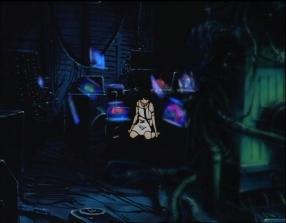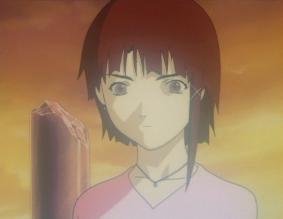|
I
first heard of Serial Experiments Lain back a number
of years ago, when I was heavily involved in the Digimon
fan community. Season 3 of Digimon, entitled Digimon
Tamers, was written by a man named Chiaki Konaka, and
was a departure from the previous two series – it was more
darkly psychological, but obviously underscored so as not
to alienate the teenage audience demographic that the series
was aimed at. I thought to myself, "What if Konaka was able
to write an adult animé series with those same qualities?"
Only recently, with the release of Lain on R2 DVD,
have I been able to see. Lain was first released
back in 2004 by MVM as single volumes with three or four
episodes each; now, the four volumes are brought together
in one full series box-set.
A
quick word of caution: given the nature of this series,
it is hard to explain without spoiling certain areas of
the plot. I've tried to limit this as much as possible.

Lain is a series that relies heavily on viewer interpretation.
It does not lay out its plotlines in an episodic fashion,
instead naming each episode a "layer" and depicting various
events in the life of the central protagonist – named Lain
– with her hallucinations and dreams given as much importance
as scenes that depict her family life and her schoolfriends.
The basic concept behind the series is that the Internet,
as we know it, has evolved into "the Wired", an all-encompassing
communications system that at times resembles virtual reality. Lain asks if the concept of "reality" can extend
to a virtual network, and if relationships and real social
interaction can take place inside a computer-generated environment.
In
some ways, Lain is a social commentary. The internet
is used today by millions of people – most use it for work,
or to study, or just as a helpful inter-office communication
system. But there are others who become so involved in the
social interactions possible on internet discussion forums
and chatrooms that they begin to see the internet as a kind
of extension of reality, and feel that online friendships
are just as valid and meaningful as those developed in real
life, away from the computer. In the series, Lain starts
off as a shy, reticent teenage girl who knows nothing of
computers and only has one to fit in with her friends. After
she receives an e-mail from a classmate who had killed herself
a week previously – in which the dead girl claims that her
"soul" is still present in the Wired – Lain begins to learn
more about computer systems and becomes more and more involved
in the social aspects of the Wired. She starts to develop
two distinct personalities; one is the same shy girl that
she's always been in real life, and the other is how she's
perceived on the Wired – as an outgoing, extroverted computer
whiz. As someone who's been involved in social communities
on the internet for many years, I can understand what's
happened – Lain has discovered that the anonymity of a network
such as the Wired gives her the power to act in a very different
way than she normally would, an create a personality that's
the complete opposite of her own.
At
first, Lain builds up a mystery amid confusing, psychadelic
imagery: strange things are happening to the Wired, and
the ones responsible are a secretive group of computer hackers
known as the "Knights". These Knights believe that there
is a "god" in the Wired, and that the barrier between the
real world and the Wired is breaking down. And, for reasons
that she can't fathom, Lain plays an integral part in their
plans. On top of all of this, Lain finds her computer usage
going too far, and begins to forget things that she's done
inside the Wired – making her two personas into genuine
split personalities.
Then,
about halfway through, the series eschews reality altogether,
becoming a series of philosophical arguments linked by nuggets
of history that are half-real and half-fictionalised, and
illustrated by imagery that grows increasingly strange and
incomprehensible. Most of the supporting characters introduced
in the previous episodes are turned upside down and viewed
only in terms of Lain's perception of them. Lain's world
itself is thrown into chaos; her own worldview and her sense
of self are challenged, and after a fateful meeting with
the Wired's "god", she starts to doubt the nature of her
own existence.

Lain is an animé of themes, not story. Almost every episode
questions the nature of reality as we know it (more specifically,
as Lain knows it) by subjecting the viewer to hallucinations
intended to blur real life with life inside the Wired. In
some places, the only clue as to whether we're viewing events
in reality or in the Wired is Lain's personality, which
– as the series progresses – becomes similarly blurred.
The series' main idea is that reality flows from thought;
the logical conclusion of "Cogito, ergo sum" ("I think,
therfore I am"). In terms of characterisation, the theme
of loneliness always surfaces. Lain's only friend is Alice,
who at times doesn't know quite what to make of Lain's new
personality, but sticks with her regardless. Lain herself
is a loner who doesn't seem to recognise when people are
trying to help her. Her sister Mika is disassociative and
condescending; her family group as a whole is dysfunctional
and apathetic.
Breaking
for a moment to talk about the series' technical qualities:
the art style used is very accomplished for the time it
was made (1998, when fast-paced and boldly-animated series
such as Cowboy Bebop arrived). Character designs
are detailed and stylised; of particular note is the method
used to draw eyes, especially those of Lain. The design
of the computer systems and their operating software is
sufficiently futuristic and works well. Soundwise, there
isn't a lot of incidental music, but what little there is
suits the mood of the series in general. In contrast, sound
effects are used heavily and often are much louder than
anything else. Viewers will be quick to note the constant
hum of the overhead power lines, but even the most innocuous
things are given emphasis: the teacher's chalk on the blackboard,
characters' heartbeats, steps coming from behind. In terms
of voice acting, the English actors do good performances,
but the translated script often feels as though the points
made were put across better in the original Japanese.
It's
hard to deny the inspirations of the series – Ghost in
the Shell, in particular, which also deals with the
idea that humans can exist outside of their bodies. I can
draw parallels between this series and .hack//SIGN,
which explores many of the same issues in a more specific
way (centered around online gaming instead of the internet
in general). Fans have perceived the influence of Neon
Genesis Evangelion, but Konaka denies this.
All
in all, Lain is a very difficult animé series
to talk about. All that I've described above constitutes
only the main underlying story, and my own interpretations
of events, and I don't pretend even for one second to fully
understand this series. Nonetheless, I'd reccommend it to
anyone who likes a series that can challenge typical perceptions
of the world around them, and isn't put off by the intense
psychological factors and imagery. Lain is an animé
that I'll likely be revisiting in the future, perhaps to
try to draw new conclusions and catch anything that I missed
the first time around, and it's one of the only series that
truly deserves to be re-watched.
The
4:3 picture displays good contrast levels, detail and colour,
which is quite vivid when it is appropriate. Black levels
are also strong and there are no obvious NTSC to PAL conversion
issues. The slightly overexposed look in places is clearly
an artistic decision that is common in modern animé
series. The subtitles are very clear and high resolution,
not the blocky, low res ones that can be found on some animé
discs.

The
Japanese and English Dolby stereo 2.0 tracks are identically
well produced and clear (echo and location atmospherics
are particularly effective). There is some clear separation
on music and effects.
Lain
provides very little in the way of extra features. On each
disc, there's a concept art gallery, which
I found to be more interesting than most such galleries
on animé discs. Also, each disc has an extras option
called "The Weird" – ten-second short animations
that poke fun at some of the events of the series. I believe
these were originally easter eggs for the Region 1 release,
but the change in menu structure forced them to become fully
selectable.
Not
strictly an "extra feature", each episode is accompanied
by a short Device clip, featuring Lain's
Japanese voice actress displaying different parts of her
body. They seem to be linked to the series' ideas of existence
without physical form. What's interesting about them is
the way they're "hidden": if you watch the series without
skipping the credits, you'll see all of the Device shorts,
but if you get bored of watching the end titles and skip,
you won't see them – even if you fast-rewind back through
the credits.
No
trailers for other series, only for Lain itself (both
TV and DVD trailers), its soundtrack album, and associated
PlayStation game.
|